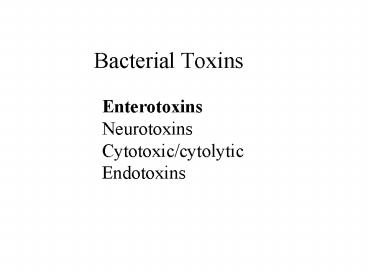Bacterial Toxins - PowerPoint PPT Presentation
1 / 16
Title:
Bacterial Toxins
Description:
Cholera toxin. Membrane Activity -A1 subunit of cholera ADP-ribosylates a ... Cholera toxin. E. coli Heat Stable enterotoxin. Heat-stable enterotoxin a (STa) ... – PowerPoint PPT presentation
Number of Views:981
Avg rating:3.0/5.0
Title: Bacterial Toxins
1
Bacterial Toxins
EnterotoxinsNeurotoxinsCytotoxic/cytolyticEndot
oxins
2
ADP-ribosylating Toxins
Cholera toxin -severe dehydration and cramps
-diarrhea is caused by the action of the
toxin-active secretion-20 L daily -agent is
Vibrio cholerae -survives well in the
environment -ingested from contaminated water
-Adherence-two proteins involved
3
Cholera toxin
-A-B subunits encoded for by ctxAB
(bacteriophage) -one A subunit, five B
subunits -Assembly and secretion -translated
units are secreted into the periplasm-assembled
and excreted into the extracellular fluid
-excretion involves the aid of a chaperone
protein (encoded by the tcpG gene) Receptor
recognition -B subunit binds to the GM1
gangliosides -A subunit is nickedA1, A2
-reduction of the S-S bond -A1 subunit is
translocated into the cell
4
Cholera toxin
Membrane Activity -A1 subunit of cholera
ADP-ribosylates a membrane protein called Gs
protein
Gs is a regulatory protein -association and
disassociation of subunits activates or
deactivates the G Protein -activates adenylate
cyclase in a hormone dependent manner -determines
the level of cAMP in host cells -Normally the
active form is due to a response to a hormonal
factor and is inactivated after a short period
of time -prevents the accumulation of cAMP
5
Cholera toxin
Gs(alpha) -ADP-ribosylation of Gs short-circuits
and locks Gs() in the on position -cAMP levels
are uncontrolled and rise to a high level -large
eflux of Na and water into the intestine of the
host results in diarrhea -no lesions in the
intestine
6
E. coli Heat Stable enterotoxin
Heat-stable enterotoxin a (STa) -Cyteine-rich
small peptide -Encoded for by the
transposon-associated estA gene located on a
plasmid Adherence -Receptor for the toxin is
located in the brush border and is called
guanylate cyclase type C Mechanism of Action
-Binding of STa to guanylate cyclase type C
causes a confirmational change -Stimulates
chloride secretion and inhibits NaCl
absorptionresulting in net sectretion
7
Clostridium
Gram () spore forming anaerobic bacteria -May
or may not be motile -Potentially highly
pathogenic to humans and animals -Produce
potent toxinsenterotoxin, -Found in soil and
in the lower intestinal tract of humans and
animals -Person-person transfer is rare -Highly
susceptible to penicillin
8
C. perfringes Type A Toxin
C. perfringes type A toxin is a common cause of
food-borne illness -noninflammatory diarrhea
-ingestion of contaminated meat or poultry or
antibiotic therapy -diarrhea, abdominal
cramping, self-limiting disease Mechanisms -CPE
binds to a protein receptor in the brush borders
-inserts into the brush border membrane
-followed by the formation of a 160 kDa protein
9
C. perfringes Type A
-formation of this protein results in
permeability changes in the membrane with loss of
intracellular K and a.a. within minutes of
toxic-protein complexing -disruption of
protein, RNA and DNA synthesis occurscalicum
dependent -leads to increased permeability and
enlarge cells with change of shape-blebbing
-lethal to the cells
10
Staphylococcus aureus
Gram () cocci -Cluster together to form bunches
of grapes -Causes acute symptoms within 2-5
hours of ingestion
11
Staphylococcal Enterotoxins
-organism present on skin, colon, vaginal tract
-causes a food-borne disease -growth at room
temperature in salad dressings, creamy foods
pre-formed toxin in foods s-ymptoms include
nausea, acute vomiting, severe abdominal pain and
diarrhea Mode of Action -ent operon for
encoding for the seven different types -active
site is on the carboxy-side of the S-S bond
-stimulate the vagus nerve ending in the stomach
lining that control the emetic (vomiting)
response -also stimulate the T-cell
response-superantigenhigh release of IL-2 which
also triggers the vomiting response in toxic
amounts
12
Shiga toxin -produced by Shigella dysenteriae
-acts on the vascular system of the vessels in
the brain and spinal cord effects both
epithelium and endothelium -acute kidney failure
in children (HUS) hemolytic uremic syndrome -the
primary role is the inhibition of protein
synthesis-not a ADP- ribosylation toxin -the
toxin is not activity excreted but is released
only during cell lysis Structure -the toxin
comprises one A and five B subunits encoded by
the stxAB operon -B subunits binds the toxin to
the host cell receptor-Gb3 ganglioside -A1 unit
needs to be nicked and reduced to be activated
13
Internalization of Toxin -entire toxin molecule
is internalized into a phagolysosome A1 is
-nicked by released enzymes -A1 becomes active
and is inserted through the membrane Inhibition
of Protein Synthesis -inactivates the 60S
ribosomal subunit -cleavage of the rRNA at this
site prevents the binding of aminoacyl-tRNA to
the ribosome -prevents protein elongation
14
Shiga-like Toxins
E. Coli 0157H7 strains -food poisoning -acute
abdominal pain and bloody diarrhea -kidney
failure can result in 10 of the cases especially
in children and older adults -vero toxin
(shiga-like toxin) is called SLT (I,II)
-identical to shiga-toxin -gene encoding the
toxin is on a bacteriophage similar to diphtheria
toxin Adherence -mediated by intimin-provides
tight binding of the bacteria to the host cells
encoded by the eaeA gene
15
C. difficile Toxin
Clostridium difficile -causes
antibiotic-associated diarrhea -increases in
incidence with age -severe form is called
pseudomembranous colitis -toxin A induces
hemorrhagic fluid secretion,damages and erodes
ileal and colonic epithelium -stimulates
chloride secretion, increases epithelial cell
permeability, and alters epithelial cell
structure Mechanisms of Action -Toxin A binds
to a G-protein in the ileal brush border
membrane -internalized via receptor-mediated
endocytosis
16
C. difficile Toxin
Mechanism of action -covalent modification of
Rho-small GTP- binding proteins involved in the
regulation of actin filament assembly -Toxin A
catalyzes the O-glucosylation of Rho subtype
proteins at a threonine thereby functionally
inactivating Rho and resulting in the
depolymerization of actin filaments































